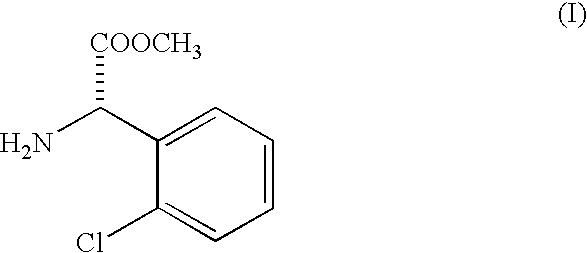Racemization of optically active 2-substituted phenyl glycine esters
a phenyl glycine and phenyl glycine technology, applied in the field of racemization of optically active 2substituted phenyl glycine esters, can solve the problems of easy degradation, high cost of discarding this material, and difficult racemization of free amino acids
- Summary
- Abstract
- Description
- Claims
- Application Information
AI Technical Summary
Problems solved by technology
Method used
Image
Examples
example 2
[0031] Racemization of methyl 2-chlorophenyl glycinate and isolation of liberated racemized ester as free base.
[0032] One hundred kilograms of methyl 2-(2-chlorophenyl glycinate (SOR -85.degree. to +5.degree.) is dissolved in three hundred fifty liters (350 liters) of methanol in a 1000 liter Mild Steel glass lined reactor. This mixture is cooled to 5.degree. C. by circulating chilled water or brine through an external jacket.
[0033] Forty five liters (73.7 kilograms) of thionyl chloride are added to the reaction mixture while stirring and maintaining a temperature of the reaction mixture between 25.degree. C. and 30.degree. C. After completion of the addition, water or brine circulation is stopped and heating of the reaction mixture begins by means of hot water circulation through an external jacket. Heating is continued and reflux is maintained for about twelve hours.
[0034] The methanol is now slowly distilled out while maintaining reduced pressure so as to maintain the temperature...
example 3
[0038] Conversion of methyl 2-(2-chlorophenyl) glycinate to its tartaric acid salt.
[0039] 60 kilograms of (+) tartaric acid (SOR=12.degree. c=20, H.sub.2O ) is dissolved in three hundred fifty liters of methanol in a mild steel glass lined reactor. Methyl 2-(2-chlorophenyl) glycinate obtained by the previous procedure (eighty kilograms) is dissolved in fifty liters of methanol and added to the reaction mixture at once. The reaction mixture is stirred for approximately five minutes and transferred to a high density polyethylene tank. Five grams of pure tartaric acid salt of methyl 2-(2-chlorophenyl) glycinate(SOR=.about.90.degree.) is added as seed. The reaction mass is kept at room temperature for ninety six hours.
[0040] Crystals of (+) tartaric acid salt of methyl-2-(2chlorophenyl) glycinate and separated by centrifugation and dried at 40.degree. C. for eight hours
[0041] Yield: -49-50 kilograms 2 Specific optical rotation [ ] D 20 = 85 .degree. - 93 .degree. ( c = 1 % in methanol )...
example 4
[0042] Isolation of Second Crop:
[0043] The mother liquor of example 3 is transferred to a reactor and the methanol is distilled out under reduced pressure while maintaining the temperature below 60.degree. C. After recovery of approximately 250 liters of methanol, the reaction mass is collected in polyethylene drums and allowed to solidify. The solid mass containing hemitartarate of (-)-methyl 2-(2-chlorophenyl) glycinate as a major product is stored as second crop for future reprocessing. Yield: About 100-120 kg. 3 SOR after drying at 60 .degree. C . [ ] D 20= - 85 .degree. to +5 .degree. ( c = 1 % in methanol )
PUM
| Property | Measurement | Unit |
|---|---|---|
| temperature | aaaaa | aaaaa |
| temperature | aaaaa | aaaaa |
| temperature | aaaaa | aaaaa |
Abstract
Description
Claims
Application Information
 Login to View More
Login to View More - R&D Engineer
- R&D Manager
- IP Professional
- Industry Leading Data Capabilities
- Powerful AI technology
- Patent DNA Extraction
Browse by: Latest US Patents, China's latest patents, Technical Efficacy Thesaurus, Application Domain, Technology Topic, Popular Technical Reports.
© 2024 PatSnap. All rights reserved.Legal|Privacy policy|Modern Slavery Act Transparency Statement|Sitemap|About US| Contact US: help@patsnap.com










